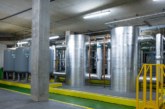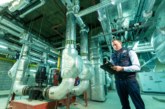Toby Heysham, Managing Director of Pinnacle Power, discusses why local authorities need to be progressive and embrace District Heating Networks
District Heating Networks (DHN) have been operating successfully in the UK for over 60 years but many local authorities are still reluctant to install them as a heat source for commercial and residential property. There is an unwillingness to change traditional methods of heat infrastructure delivery and make the progressive move to a cheaper and lower carbon use of local resource. This is further exacerbated by negative media coverage of spiralling consumer costs, confusing ‘communal heating’ with District Heating.
However, in October, as part of Green GB Week, the Government launched the Heat Networks Investment Project (HNIP), bringing together £320m of government loans, grants and additional investment from energy companies. Heat is the next big target for the Government in its battle to hit its legally binding targets to deliver lower carbon emissions and it is looking to local authorities to take a lead in switching the UK’s denser populated areas to DHN as an important part of its decarbonisation strategy. With heat making up 30-40% of carbon emission output in the UK, the financial incentives for local authorities are increasingly being made available, but there are far more benefits not being articulated.
DHNs enable lower emissions and lower carbon and as a result higher efficiencies and better pollution control. This in turn creates a cleaner and more sustainable environment as well as helping achieve the Government’s ambitions. This is not a call to ‘end gas’, this is a call to use local resources and provide the infrastructure, where appropriate, to deliver a cleaner, greener energy system. We should demonstrate increased progressive and innovative practices above burning gas in the middle of a densely populated town or city.

Consistent supply
Not only should a centralised DHN supply be cheaper than traditional local heating systems but also they deliver a more consistent output, making it less likely for a household — or housing block — to lose its supply. Copenhagen is 95% heated by DH and most of the Northern European cities have extensive DH networks. One of the core reasons for the slow uptake here in the UK is the confusion over ‘why’ and ‘how’ heat is lost, and currently DHNs are taking the blame for rising consumer costs. In reality this arises when DHNs are attached to outdated and badly designed ‘in building’ distribution systems, it is not the system taking the heat up to the building.
With no long-term obligation from those who build these systems, the design of in-building, communal heating often does not consider long-term use, are badly insulated and massively oversized from the outset. A tradition has been to oversize a heating system between two and 10 times what is required causing unnecessary inefficiencies and expense.
This lack of information, and repeated misinformation, about the wider benefits of DHN is one of the many challenges the government needs to overcome if it wants local authorities to engage. The formation of the HNIP will go someway to help this as well as enabling local authorities to use the new funds to develop partnerships that can support in the sharing and managing of risk. Those partnerships can be developed through two approaches.
- Self-delivery — A local authority can borrow capital and implement a system themselves by working with a design, build and delivery partner. The crucial element to this relationship is that it is a collaboration. By having a long-term partnership it is possible to use the skills and resource of the private sector alongside the long-term view and drive of the local authority.
- Partnership approach — Within a financial partnership, a local authority works with a partner to help deliver the DHN financially as well as practically so both the council and partner invests with equal interest in the long-term success of the DHN. This method alleviates the full financial burden from the council. The important decision for this approach is whether the partner is funder or installer. At present the two are being confused.
Overcoming technical challenges
There are specific technical challenges when implementing a DHN but these should be no more complex than when delivering any infrastructure project. The key is to get the strategy direction set at the beginning. The first step is to make sure all the potential connections of an existing system can be connected to and have been spoken to. Pipe installation can require road closures so connections from the DHN to the site can be made; this has to be managed across the council departments as well as with the public.
There is still a reluctance for those with an energy centre to share the heat they produce; commercial operations are still very insular in their approach to heat, they want to use their own heat and not see their energy centres as an asset through which to sell heat. Not only do local authorities need convincing of the long-term benefits of a DHN, but also they then need to convince their local stakeholders to engage.
Less than 2% of buildings in the UK are connected to a DHN, despite the overarching benefits. The target is 17%. This is a massive increase and will require local authorities to look at their heat users, their generators and their long-term utility strategy, then think hard about whether there is a desire to follow the lead of other Northern European cities of using their local resources to their advantage. So many urban areas in the UK have already made great strides and are really moving on this, the challenge is to now deliver. The HNIP has given us a platform to grow this figure but those in the industry have to take a responsibility to spread the right information and encourage partnerships to get on board.









